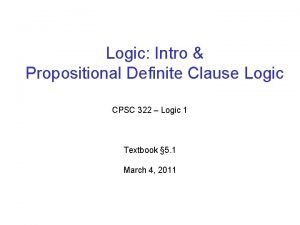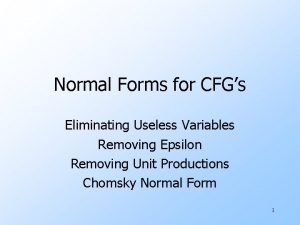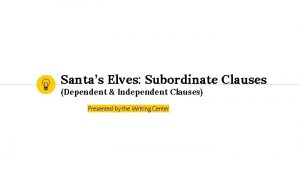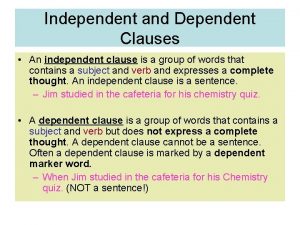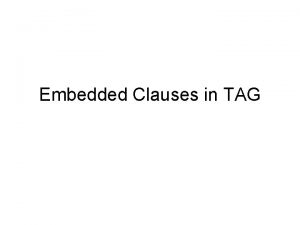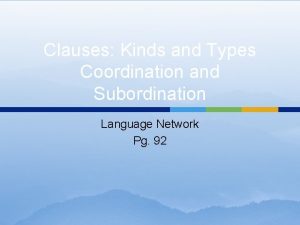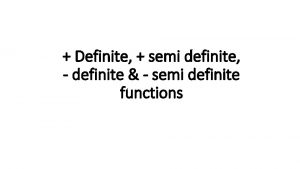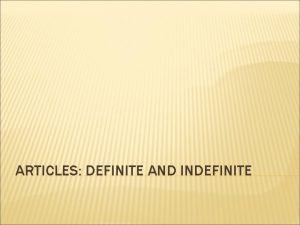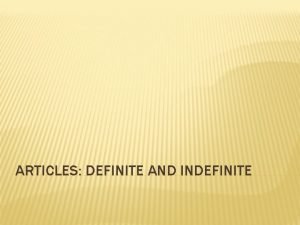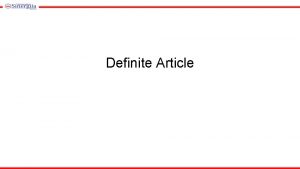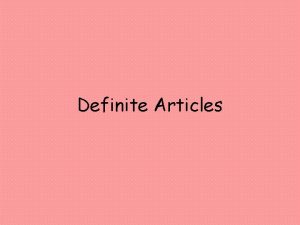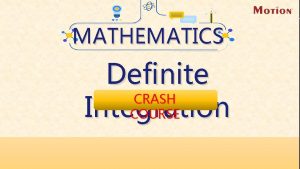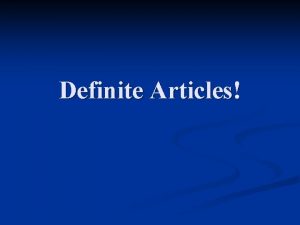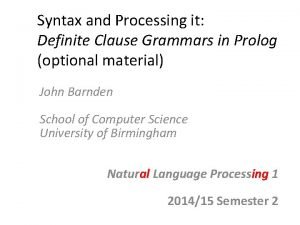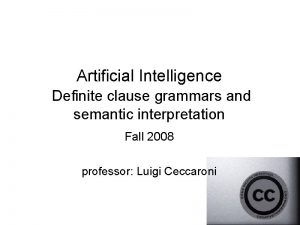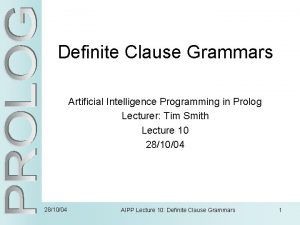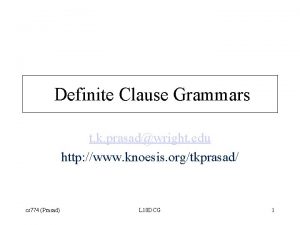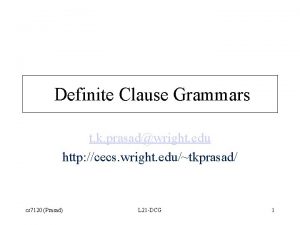An Introduction to Definite Clause Grammars Grammars and



![Running the Recogniser ? - s([the, monkey, grinned]). yes. ? - s([the, monkey, spat]). Running the Recogniser ? - s([the, monkey, grinned]). yes. ? - s([the, monkey, spat]).](https://slidetodoc.com/presentation_image_h2/bfa66933633d1e018bece3e30b433a25/image-4.jpg)



![Running the Recogniser ? - s([the, monkey, grinned], []). yes. ? - s([the, monkey, Running the Recogniser ? - s([the, monkey, grinned], []). yes. ? - s([the, monkey,](https://slidetodoc.com/presentation_image_h2/bfa66933633d1e018bece3e30b433a25/image-8.jpg)






- Slides: 14

An Introduction to Definite Clause Grammars • Grammars and Algorithms • Prolog Recogniser • DCGs Feb 2008 - MR Definite Clause Grammar 1

CF Recognition in Pure Prolog • Use lists to represent strings. the monkey grinned [the, monkey, grinned] • Reinterpret CF rules as Prolog clauses s ® np vp s : - np, vp. • Use append to concatenate the strings s(Z) : - np(X), vp(Y), append(X, Y, Z) • Reinterpret lexical rules as simple assertions n ® [monkey] becomes n([monkey]). Feb 2008 - MR Definite Clause Grammar 2

Complete Recogniser Program s(Z) : - np(X), vp(Y), append(X, Y, Z). np(Z): - d(X), n(Y), append(X, Y, Z). vp(Z): - v(Z). d([the]). n([monkey]). v([grinned]). v([danced]). Feb 2008 - MR Definite Clause Grammar 3
![Running the Recogniser sthe monkey grinned yes sthe monkey spat Running the Recogniser ? - s([the, monkey, grinned]). yes. ? - s([the, monkey, spat]).](https://slidetodoc.com/presentation_image_h2/bfa66933633d1e018bece3e30b433a25/image-4.jpg)
Running the Recogniser ? - s([the, monkey, grinned]). yes. ? - s([the, monkey, spat]). no. ? - s(X). X=[the, monkey, grinned]; X=[the, monkey, danced] Feb 2008 - MR Definite Clause Grammar 4

Difference Lists • Using append is very inefficient. • We can avoid append by using difference lists. • Key idea is to represent a string as the difference between two lists. • For this purpose we employ two pointers. Feb 2008 - MR Definite Clause Grammar 5

Difference Lists • Here are different ways of representing the string abc [a, b, c] [ ] [a, b, c, x] [a, b, c, x, y] [x, y] • a • b • c • x • y • P 1 Feb 2008 - MR P 2 Definite Clause Grammar 6

Recogniser Using Difference Lists s(X, Z) : np(X, Z): vp(X, Y): - np(X, Y), vp(Y, Z). d(X, Y), n(Y, Z). v(X, Y). d([the|Rest], Rest). n([monkey|Rest], Rest). v([grinned|Rest], Rest). v([danced|Rest], Rest). Feb 2008 - MR Definite Clause Grammar 7
![Running the Recogniser sthe monkey grinned yes sthe monkey Running the Recogniser ? - s([the, monkey, grinned], []). yes. ? - s([the, monkey,](https://slidetodoc.com/presentation_image_h2/bfa66933633d1e018bece3e30b433a25/image-8.jpg)
Running the Recogniser ? - s([the, monkey, grinned], []). yes. ? - s([the, monkey, spat], []). no. ? - s(X, []). X=[the, monkey, grinned]; X=[the, monkey, danced] Feb 2008 - MR Definite Clause Grammar 8

Difference Lists Advantages • append not used • efficiency Disadvantages • More difficult to understand the interpreter Can we retain advantages and eliminate disadvantages? Feb 2008 - MR Definite Clause Grammar 9

Definite Clause Grammars (DCGs) s vp vp d v np np --> --> Feb 2008 - MR np, vp. v. v, np. [walks]. [hits]. [suzie]. [fido]. Definite Clause Grammar 10

How DCGs are compiled • We run the DCG recogniser in exactly the same way as we run the difference-list recogniser. • The reason is that DCG notation is just syntactic sugar. The DCG rule x --> y, z. is actually compiled into an ordinary clause x(V 1, V 2) : - y(V 1, V 3), z(V 3, V 2). • whilst the preterminal rule x --> [word]. compiles to the clause x([word|W], W]). Feb 2008 - MR Definite Clause Grammar 11

Use of Curly Brackets • Suppose we have s(Z) -> np(X), vp(Y). and there is an ordinary predicate p(X, Y, Z) which operates on the arguments. • We enclose the ordinary predicate in curly brackets to avoid the automatic addition of two argument places. s(Z) -> np(X), vp(Y), {p(X, Y, Z)} Feb 2008 - MR Definite Clause Grammar 12

Adding Features • Suppose we wish to impose number agreement between np and vp • To solve the problem of multiplying categories, we need to add feature constraints to our grammar specifications, in order to express the following sort of fact s ® np vp constraint: number(np) = number(vp) • Fortunately we can do just that because the constituents of rules can be full Prolog terms, which may include variables arguments. Feb 2008 - MR Definite Clause Grammar 13

Fixing the Grammar OLD GRAMMAR NEW GRAMMAR s np np vp s np(N) vp(N) --> --> Feb 2008 - MR np, vp. n. d, n. v np. Definite Clause Grammar --> --> np(N), vp(N). n(N). d(N), n(N). v(N), np(_). 14
 Rrs research
Rrs research Unrestricted grammer
Unrestricted grammer Questions on context free grammar
Questions on context free grammar Every linear grammar generates a regular language
Every linear grammar generates a regular language Eliminate useless symbols
Eliminate useless symbols Types of grammar
Types of grammar Main clause and subordinate clause
Main clause and subordinate clause Phrases vs sentences
Phrases vs sentences What is a clause example
What is a clause example Whats a dependent clause
Whats a dependent clause First conditional of come
First conditional of come Embedded clause
Embedded clause Coordinate and subordinate clause
Coordinate and subordinate clause Difference between noun clause and adjective clause
Difference between noun clause and adjective clause If-clause and main clause
If-clause and main clause
